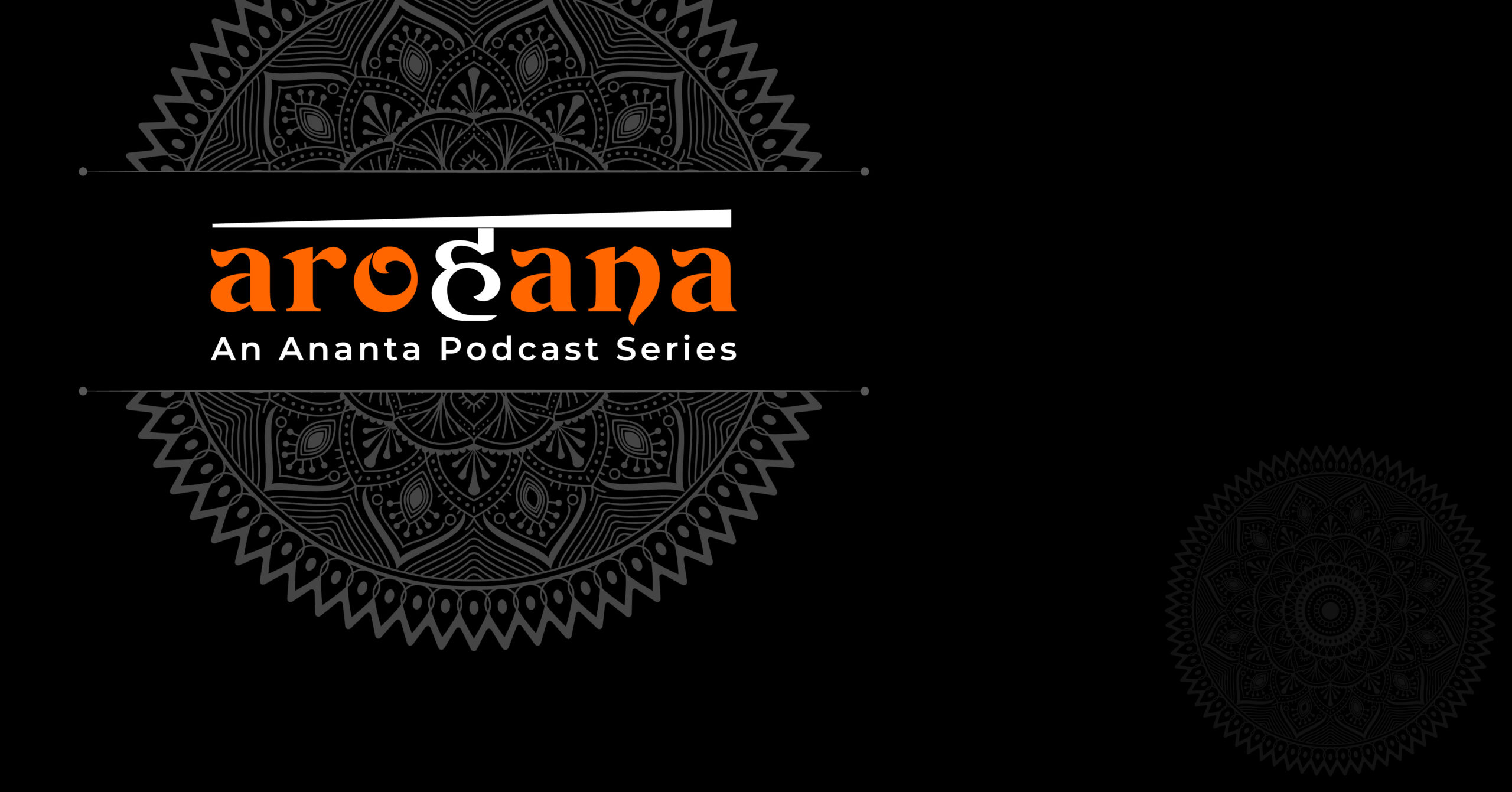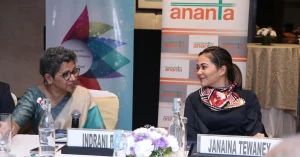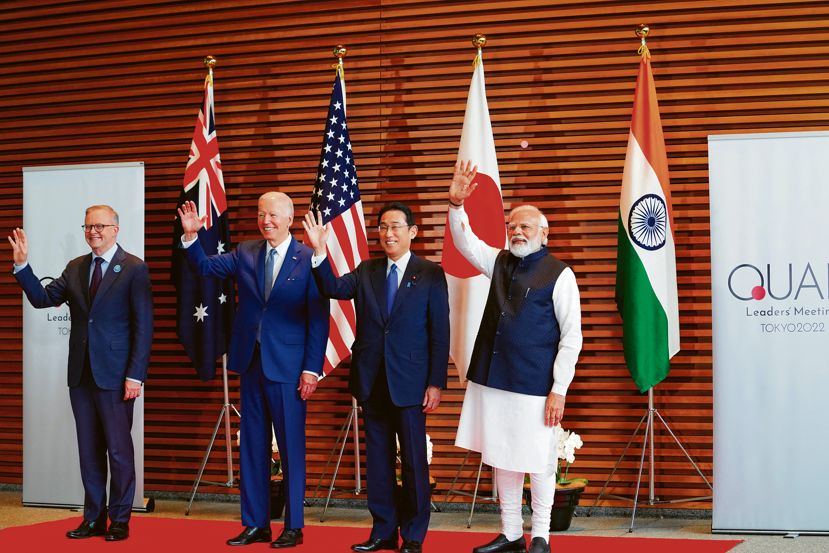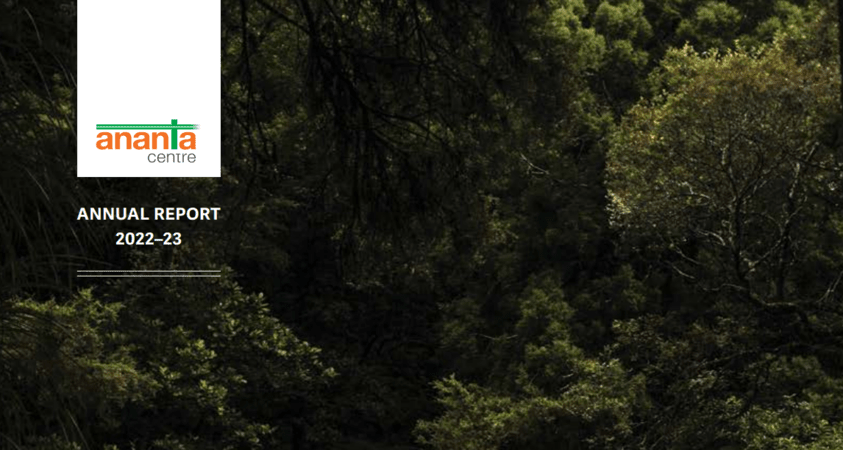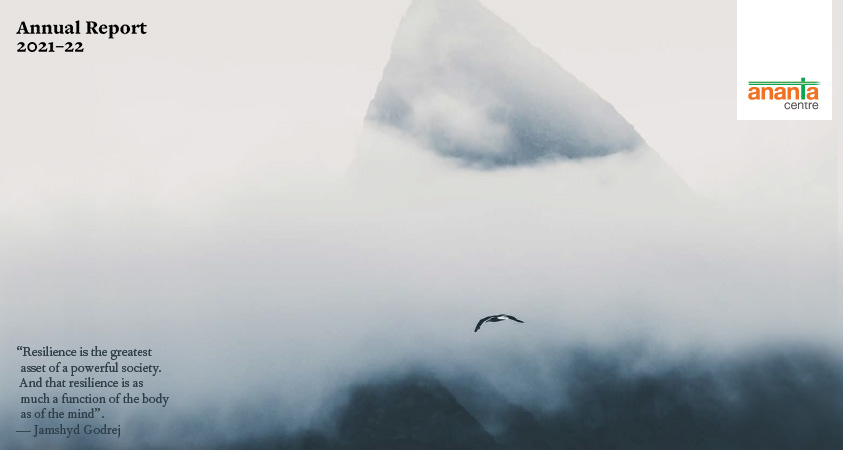HIGHLIGHTS
- Draft telecom bill triggers debate over regulation
- Worries over rupee depreciation and the CAD problem
- Liquidity crunch signals fresh challenges for growth
- Cabinet moves on logistics, chips and solar power
- India Inc capital expenditure rising slowly
- Tax buoyancy continues; 2nd half growth may slow
- Mixed signals from GDP and inflation numbers
- Facelift for Railways’ land monetization policy
- RBI cracks the whip on illegal lending apps
Draft telecom bill triggers debate over regulation
The government has unveiled for public discussion a draft telecom bill, which would replace the 137-year old Indian Telegraph Act, the Indian Wireless Telegraphy Act of 1933 and the Telegraph Wires (Unlawful Possession) Act of 1950. The draft bill has many provisions that have kicked up a storm. The bill proposes that calling and messaging services such as WhatsApp, Zoom, Skype and Google Duo would need licences to operate in the country. Even Over The Top (OTT) applications would be treated as telecommunication services and would need to obtain a licence. The new provisions also dilute some crucial powers and responsibilities of the Telecom Regulatory Authority of India or TRAI on the question of issuing new licences to service providers. Equally important, in case of insolvency of a telecom service operators, the spectrum assigned to the entity shall revert to government control and the Union government would take such action as would be prescribed including allowing such licensees or assignees to continue to the use the spectrum. Renaming the Universal Service Obligation Fund as Telecommunication Development Fund is another provision in the draft law. Significantly, the proposed TDF would be first credited to the Consolidated Fund of India, which would mean the Centre could use those resource for its other schemes. There are also provisions for the refund of fees if a telecom or internet provider surrendered its licence. The Centre could waive in part or full any fee or any licence holder or registered entity under the rules. Predictably, the draft bill, now open to public debate and consultation, has already triggered a volley of protests from different quarters. While OTT application operators and messaging services are questioning the move to bring them under a licensing regime, there are murmurs of protest even within the TRAI as its regulatory powers are proposed to be diluted. Even the information and broadcasting ministry is reportedly unhappy over the way its jurisdiction over OTT communications services, and other broadcasting services are to be treated as telecommunication services and subjected to the control of the telecommunications department. Broadly, the increase in control of the government over this sector and diluting the powers of the regulator are issues that would be intensely debated over the next few months.
Worries over rupee depreciation and the CAD problem
The Indian currency has continued to remain volatile and lose its value in relation to the US dollar, even though its depreciation has been less steep in the current year compared to other currencies of the world. The decline got accentuated after the US Fed Reserve announced its third consecutive rate hike of 75 basis points in the last week of September. Even as the Indian stock markets also bore the brunt of the US Fed Reserve’s rate hike, the Indian rupee’s fall to over Rs 81 against a dollar implied a depreciation of over 9 per cent this year. Compared to previous similar crises, the Indian rupee’s fall now has been much less compared to 21 per cent during the taper tantrum days between April 30,2013 and September 3, 2013 and 19 per cent during the Great Recession days between January 1, 2008 and December 31,2008. Even when compared to many other inter currencies, the fall of the Indian rupee has been less steep. Worryingly, however, India’s foreign exchange reserves have seen depletion by a bigger amount of $86 billion between February and September 2022, compared to a depletion of about $22 billion between April and September 2013 and $58 billion between March 2008 and March 2009. A bigger worry is on account of the widening current account deficit, which compared to 1.2 per cent in 2021-22 could widen to over 3.5 per cent of GDP in 2022-23. Both the rupee movement and the trajectory of current account deficit along with the level of foreign exchange reserves will be closely watched by the RBI and the government in the coming weeks and months.
Liquidity crunch signals fresh challenges for growth
For the first time in about three years, the liquidity in the country’s banking system slipped into a deficit. This is a significant shift, indicating how the Reserve Bank of India’s policy on tightening the monetary policy since May this year has begun to show some results. The RBI’s daily data on money market operations as on September 21 showed that the central bank had infused net liquidity worth Rs 21,873 crore into the banking system – which was the highest amount since May 2019. This also means that commercial banks are now borrowing from the RBI through its marginal standing facility at the rate of 5.65 per cent, higher than the repo rate of 5.4 per cent. As expected, the overnight call rates, at which banks lend to one another to meet their temporary mismatches in deposits and credit, also have risen to a three-year high of over 5.5 per cent. What can now be safely expected is that commercial banks would soon increase the interest rate for their fixed deposits. Another likely development is an increase in the repo rate when the Monetary Policy Committee of the RBI completes its deliberations on September 30. Money market experts and analysts are sanguine that there would be another rate hike of 35 to 50 basis points. If this were to happen, then the RBI’s interest rate regime would see an increase of 175-190 points in the repo rate in just about four months since May 2022.
Cabinet moves on logistics, chips and solar power
The Union Cabinet on September 22 took three important decisions with significant ramifications for the Indian economy. The first decision was to approve a national logistics policy to facilitate seamless movement of goods across the country and improve the competitiveness of Indian goods in the domestic and export markets. The new policy has three specific goals. One, the goal is to bring the cost of logistics down from the current 12-13 per cent of gross domestic product or GDP to closer to the 8 per cent level that prevails in developed countries. A lower cost of logistics improves competitiveness in the economy. The second goal is to raise India’s rank in the global logistics performance index from the current 35 to less than 30 in the next eight years. The third goal is to create a data-driven decision support mechanism. The Union Cabinet’s second decision was to tweak the Rs 76,000-crore incentive scheme for semiconductors and display manufacturing units. The modified scheme envisages that the government would provide 50 per cent of the project cost for all semiconductor fabrication facility by way of capital support. This would modify the existing production-linked incentive scheme already in operation for such chip making facilities in the country. Under the modified policy, the government would provide a uniform capital and fiscal support of 50 per cent of the project cost across all types of semiconductor facilities. The third decision of the Union Cabinet was to approve a Rs 19,500-crore proposal of the Ministry of New and Renewable Energy for the second tranche of the production-linked incentive scheme for solar equipment manufacturing. The decision is expected to promote the manufacture of photovoltaic modules in the country to help the country achieve the goal of adding 65 gigawatt of annual manufacturing capacity of fully and partially integrated solar photovoltaic modules. While the national logistics policy is to complement the Gati Shakti project, already under execution to give a boost to execution of infrastructure projects, the common element in the other two Cabinet decisions was that they reflected the government’s policy of Atmanirbharata or self-reliance.
India Inc capital expenditure rising slowly
A data set that provides an indication of what may be happening in the real sector of the Indian economy shows that India Inc grew its capital expenditure by a decent rate of 9.1 per cent in 2021-22, according to a study. This is higher than the growth of 7.4 per cent in such expenditure incurred in 2020-21. Capital expenditure would imply investments in plants, equipment, land buildings and acquisitions for setting up new projects. Although the average rise in India’s Inc’s capex in 2020-21 and 2021-22 was slower than in the pre-pandemic years, the 9 per cent growth last year would indicate that Indian companies are gradually gaining an appetite for more investments. A slightly worrying aspect of this growth is that the rise in capital expenditure is led largely by top companies and industry leaders. The small and medium companies have been laggards in this area, compared to the large companies. The bottom 25 per cent of the listed firms (measures by their revenue) reported a year-on-year increase in the capital expenditure of only 3.1 per cent in 2021-22. In other words, the increase in the top 75 per cent of the listed companies was more than the average 9.1 per cent rise in capital expenditure of the entire lot which consisted of about 820 non-financial companies figuring in various Bombay Stock Exchange indices like BSE500, BSE Midcap and BSE Smallcap. The growth in capital expenditure by these listed companies underlines how the bigger firms have done better even in terms of investments, confirming the prevalence of the K-shape phenomenon even in this area. But the fact that the latest Reserve Bank of India survey shows that manufacturing companies are reporting a capacity utilization level of over 75 per cent should mean that in the current year, the capital expenditure by these companies should maintain a healthy growth rate.
Tax buoyancy continues; 2nd half growth may slow
The Centre’s tax buoyancy continued to cheer the managers of the economy in the finance ministry. Net direct tax collections from April 1 to September 17, 2022 (excluding refunds) were estimated at Rs 7 lakh crore, compared to Rs 5.68 lakh crore in the same period of 2021 – an increase of 23 per cent. The government had budgeted for a total direct tax collections of Rs 14.2 lakh crore in the full year of 2022-23. This was just about 2.5 per cent more than the Rs 13.85 lakh crore collected in 2021-22. Clearly, a growth rate of 23 per cent in the first half augurs well for direct tax collections. The achievement for the full year will surely be much more than what was budgeted for 2002-23. Collections of goods and services tax (GST) are also maintaining a healthy pace. In the April-August 2022 period, GST collections grew by 33 per cent, with the monthly collections staying above Rs 1.4 lakh crore for the sixth month in a row, ended August 2022. Such growth reflected the revival in consumption, improved compliance and elevated inflation. There is, however, expectation that the tax collections growth in the second half of the current financial year would decline a bit in view of the incipient stress building in various sectors of the economy, thanks to the elevated price of crude oil, fears of a global recession affecting India’s growth and exports, and a falling rupee against the US dollar. Advance tax collections for corporation and personal income taxes in the first quarter rose by 33 per cent, but in the second quarter the growth fell to 12 per cent. GST collections too may grow by just 20 per cent in September and could settle down at 12-15 per cent in the third and fourth quarters of the year. Growth in excise and Customs duty collections have remained tepid, as reflected in a decline by 15 per cent (Rs 85,000 crore) and 12 per cent (Rs 51,000 crore), respectively, in the April-July 2022 period. This is because the government had cut excise duty on petroleum products and imports too fell. These factors would bring down the full year’s overall tax revenue growth, but they would still be substantially more than the gross tax collections target of Rs 27.58 lakh crore, thereby providing some cushion to the fiscal balance by offsetting the extra expenditure incurred under some heads like free food supply scheme.
Mixed signals from GDP and inflation numbers
Signals from India’s macroeconomic indicators in September were mixed. Growth in the country’s gross domestic product or GDP in the April-June quarter of 2022 was 13.5 per cent, even though it was on a low base of the same period of 2021, when the Delta wave of Covid-19 had adversely impacted the economy. Even against the projection of the Reserve Bank of India at 16.2 per cent, the actual number put out by the National Statistical Office was a disappointment. Another way of looking at the national income data for the first quarter of the current financial year is to compare it sequentially over the previous quarter, which placed it at a contraction of 9.6 per cent. Year-on-year, however, agriculture reported robust growth at 4.5 per cent, manufacturing at 4.8 per cent, construction at 16.8 per cent and services reported growth at 17.6 per cent. Private spending growing at about 26 per cent gave rise to hope, but subdued government spending at 1.3 per cent was a disappointment. The July 2022 numbers for industrial growth were a cause for further introspection on the trajectory of the economy in the months to come. Industrial growth in July 2022 was only about 2.4 per cent and sequentially it represented a contraction of 2.7 per cent compared to June 2022. What made the macroeconomic situation a little worrying was the increase in the retail inflation rate to 7 per cent in August 2022, up from 6.7 per cent in the previous month. The increase in retail inflation meant that the Reserve Bank of India will most likely have to explain to the government why it has failed to keep the inflation rate below 6 per cent for nine consecutive months and what it plans to do to bring it down to that level. Retail food inflation also went up to 7.62 per cent in August 2022. Even though the wholesale prices-based inflation decelerated in August to 12.41 per cent, it was still in double digits and stayed in that range for the last year and a half. The wholesale prices were under pressure in spite of manufactured goods and fuel prices moderating but food inflation accelerated to 12.37 per cent causing concern to the manager of the economy. In spite of this growth, the elevated levels of inflation would give a trying time to those who would be deciding on the monetary policy stance at the end of September.
Facelift for Railways’ land monetization policy
In a major decision to improve the Indian Railways’ revenues from monetization of its land assets, the Cabinet Committee on Economic Affairs has made the norms for granting long-term railway land lease more attractive. Accordingly, the Railways’ land licensing fee will come down from the current 6 per cent (with a 7 per cent annual increase) to 1.5 per cent of the market value of the land. The lease period also has been extended from five years now to 35 years. The relaxed terms would also help facilitate the government’s plan for a strategic sale of its equity stake in Container Corporation of India. The Cabinet believed that libealising the railway land leasing policy would open avenues for all stakeholders, service providers and operators to establish more cargo-related facilities and render their participation, assisting in the generation of additional cargo traffic and freight revenue for the Indian Railways. The new land licensing fee policy is expected to generate a revenue potential of Rs 30,000 crore over the next five years, to be earned through augmented freight volumes carried through over 300 Gati Shakti cargo terminals proposed to be set up across the country. Earlier the target was to set up only 100 cargo terminals. The Indian Railways’ calculation of Rs 30,000 crore of revenue is based on the assumption that each new cargo terminal would be adding Rs 100 crore extra revenue to its kitty. The revenue target is quite ambitious as, according to the Indian Railways, all Gati Shakti cargo terminals should help the country’s largest transporter generate Rs 60,000 crore of revenue at its maximum potential. Hence, the target of Rs 30,000 crore in the next five years is considered to be a conservative estimate, according to an internal analysis within the Indian Railways.
RBI cracks the whip on illegal lending apps
The Reserve Bank of India has cracked down on illegal digital lending platforms. This is the central bank’s response after it came to its notice that several illegal loan applications hosted on various digital application stores had offered micro credit to the pandemic hit people and low-income groups at interest rates that were exorbitant. These instances also revealed that the lending applications had included processing charges that had not been made explicitly clear before granting the loans. In addition to such hidden processing charges, they also resorted to predatory recovery practices. The RBI has, therefore, decided to prepare a “white list” of all legal applications offering loans and the Union ministry of electronics and information technology have been entrusted with the task of ensuring that such applications were hosted on digital application stores. Among the many steps that the apex banking regulator would initiate in this regard are: Monitoring rented accounts that could be used for money laundering, review or cancel dormant non-banking financial companies to prevent their misuse, increase cyber awareness for customers, bank employees and law enforcement agencies and ensuring that registration of payment aggregators was completed within a timeframe and no unregistered player was allowed to function after that. India’s recent record in the digital transactions space has been phenomenal. In August 2022 alone, over 6.5 billion digital transactions valued at over Rs 10.7 lakh crore were completed, showing a penetration that was one of the highest in the world. The RBI action on lending apps is aimed at ensuring that the fast spread of digital transactions is not curbed by unscrupulous players.
Supported by
………………………………………………………………………………………………
(The views expressed are personal)
………………………………………………………………………………………………




